The Grey Blob just seems to like pressing you further and further east. Has the Golden Horde converted yet?

The Return of Ancient Gods: Lithuanian Kingdom
- Thread starter unmerged(47028)
- Start date
-
We have updated our Community Code of Conduct. Please read through the new rules for the forum that are an integral part of Paradox Interactive’s User Agreement.
You are using an out of date browser. It may not display this or other websites correctly.
You should upgrade or use an alternative browser.
You should upgrade or use an alternative browser.
Nice to finally be scoring points on the Big Grey Blob! Are you actually winning the war though, or just holding your own? I get the impression the HRE can put together 43,000 more men faster than you can find 17,000.
I think that was your best update yet mnplastic. It's always nice to see someone land a blow against the HRE behemoth. 
A very interesting update - and good to see a Lithuanian victory in a battle against the Empire.
Hopefully this will breed more successes for Girdenis and his descendants.
I was waiting for this victory for a while now. However, this evil empire still has almost 3 times more troops.
The Grey Blob just seems to like pressing you further and further east. Has the Golden Horde converted yet?
The Golden Horde is already Orthodox. The Grey Blob now pressing not only me but also pagan Hungary which converted back to paganism after almost 400 years of Christian rule.
Nice to finally be scoring points on the Big Grey Blob! Are you actually winning the war though, or just holding your own? I get the impression the HRE can put together 43,000 more men faster than you can find 17,000.
You are right. The HRE is recovering much faster. There are about 40,000 Imperial troops in Hungary versus my total 40,000 (12,000 is in Meklenburg) and some Hungarian troops but those are busy with Hungarian Christian rebels. At the moment is a draw and do not have enough money to restore my retinue while the HRE is employing at least two Holy Orders.
I think that was your best update yet mnplastic. It's always nice to see someone land a blow against the HRE behemoth.
Thanks Tazhang! That was a period of a lot of hot action. The HRE before was defeating me in no time. I think this time it won't be that easy fighting two sizeable pagan countries. Besides the destruction of Imperial Forces could lead to a Civil War in the HRE which is very welcome.
I somehow missed this very interesting AAR. Subscribed!
Welcome, Vizier! I hope you will enjoy the remaining years of the pagan history.
Appease two of them, imprison the third, and when the fourth rebels, crush him ^^
Luckily one was removed by the Queen Mother, one was destroyed by the HRE and one was arrested for a conspiracy. The revolt ended in white peace because the HRE at the end "helped" too
Last edited:
King Girdenis IV the Great (Part II)
The war between Emperor Ordulf the Ill-Ruler and the alliance of Gedvilas of Hungary and Girdenis IV of Lithuania lasted for another 6 years. Neither side was able to gain an upper hand in the war. Lithuanians kept the Imperial Baltic coast and Teutons remained in Esztergom. Several battles followed but none of them had any significance. Due to the stalemate the parties met at Arva Vara, Duchy of Nyitra on 17 March 1411 and signed a peace treaty. In order to secure long lasting peace Girdenis IV agreed to marry his oldest daughter Anele to Ordulf’s third son Dietpold.
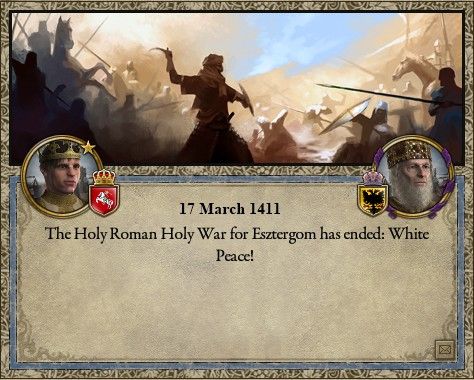
Duchess Engeltraud von Sponheim the Great of Carinthia, grandmother of Reinhard Gediminaitis, raised German dukes against Emperor Ordulf in an attempt to regain freedoms once enjoyed by their ancestors. Soon after that the Italian League led by Duke Dietrich IV von Querfurt of Modena began independence war.
Peace did not last long in Lithuania too. Russian princes and boyars rebelled with some support of Lithuanian traitors.
In April 1414, Pope Theodore III declared a Crusade for Hungary. Seven months later the Pope died but new elected Pope Formosus II continued the Crusade. Girdenis IV who was preoccupied with Russian rebels sent two armies to Hungary but by the time they arrived Hungary was devastated by Crusaders. Gedvilas of Hungary fled to Slavonia. On 28 March 1415, he surrendered to Serene Doge of Venice Cangrande di Ravenna. Venetians who financed the Crusade were given the majority of Hungary. Many Hungarian nobles who lost their land fled to Lithuania.

Serene Doge of Venice Cangrande di Ravenna *
On 21 January 1416, Gedvilas was murdered together with his second two year old daughter Etel while staying in Krete, probably under the orders of Greek separatists or maybe disappointed Hungarian nobles who saw him as a traitor and Lithuanian puppet.
Gedvila’s daughter Gyorgyi who luckily stayed with her mother Kenna in County Szekelfold during the murder was crowned as the Queen of Hungary or better say what was left of it.
Girdenis IV returned to Lithuania and crushed the rebels. The loss of a major ally was very painful and Girdenis IV decided to begin a re-conquest of Hungary. In May 1418, war was declared against Venice.
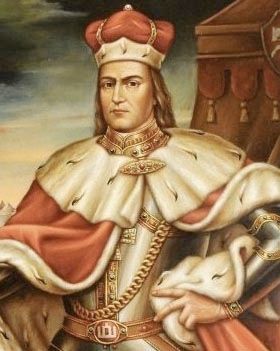
Girdenis IV the Great **
Three months later, Lithuanian armies invaded the Duchy of Ungvar. It took time for Venetians to gather an army of mercenaries and crusaders. On 6 March 1420, 45,000 strong Lithuanian army met 42,000 strong Venetian army at Vac, County Pest. Lithuanian veterans of the war against the Empire broke the left flank led by Hochmeister of Teutonic Order Berengar Niklotid the Drunkard and then surrounded and crushed the remaining Venetian forces. Cangrande and some other leaders, including Grandmaster of Knights Hospitaller Comita de Savoie Ironside managed to avoid capture. Venetians could no longer resist and Cangrade sought truce on 15 May 1420. Kristof Csak the Cruel was returned his Duchy of Ungvar.
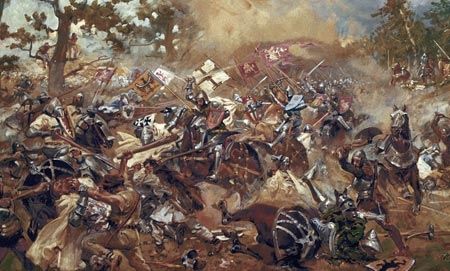
The Battle of Vac ***
After the victory against Venice, Hungarian nobles turned their heads towards Lithuania. On 26 September 1421, Queen Gyorgyi fell out a window of castle in Zagreb while playing and died. Nobody was accused of killing but everybody suspected pro-Lithuanian supporters. Girdenis IV wife Anele, older sister of Gedvilas of Hungary became the Queen of Hungary.

Soon after the war against Venice in 1422, Girdenis IV invaded the Republic of Beloozero and seized Novgorod. In 1423, he married his oldest and only son Girdenis to Princess Eleanor Plantagenet of England, the daughter of King Gregory the Wise. King Gregory in 1410 defeated King Ralph, son of King Alan the Just (who overthrew previously the Cathar king) and usurped his throne. Gregory’s ancestors including farther, grandfather and grand-grandfather, King Peter the Strong the first Cathar king were Cathars but he converted to Catholicism in order to get a support against King Ralf.
In 1424, Girdenis IV married his daughter Danilla to Prince Bard Crovan of Scotland. Two years later Bard became the King of Scotland but just 8 months into his rule Bard was murdered. His newly born son Kenneth Crovan became a king. In 1435, Scottish nobles under leadership of Christina Crovan, sister of Kenneth’s Grandfather Fergus of Scotland rebelled. On 7 April 1435, Kenneth with his mother Danilla fled to Lithuania.
By 1430, Emperor Ordulf subdued the Italian League. On 29 September 1433, Duchess Engeltraud of Carinthia died. However, her grandson Reinhardas Gediminaitis took over the leadership of the rebellion his grandmother started. On 14 January 1434, Emperor Ordulf died of consumption. He was the oldest monarch in Europe and outlived his five wives. At the end of his life Ordulf married to sixth wife Ursula von Hohenstaufen, descendant of Sicilian Kings deposed by Ordulf himself.
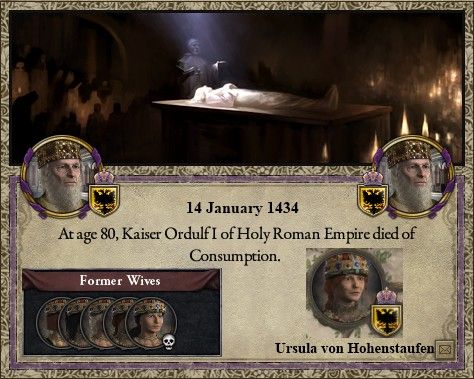
Ordulf had 6 children – 4 sons and 2 daughters.
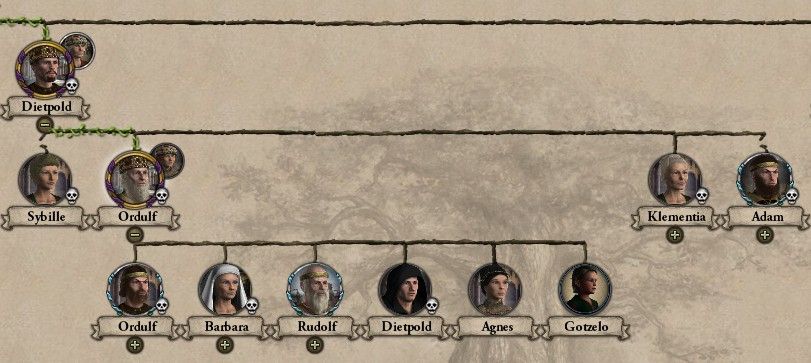
He had his first son Duke Ordulf II of Greater Poland with his lover Ursula. Ursula was previously Ordulf’s father’s, Dietpold II lover. She had with him son Duke Adam of Nyitra, Ordulf’s half-brother.
With his first wife, Barbara Askanien, Ordulf had daughter Princes Barbara and two sons Duke Rudolf of Susa and Prince Dietpold. Empress Barbara was considered genius but it was suspected that she preferred women which led to Ordulf’s infidelity. Prince Dietpold married to Anele of Lithuania, daughter of Girdenis the Great but died childless.
The second wife, Walpurga Wettin was a widow of Duke Peter II of Holland. She had no children with Ordulf.
The third wife, Kriemhild von Oberbayern, was imbecile but she gave birth to Princes Agnes.
The forth wife, Giuseppa was a widow of Baron Bruno of Gatteo. She had no children with Ordulf.
The fifth wife, Ermengard von Hohenstaufen was daughter of Ordulf’s half-brother, Duke Adam of Nyitra. She gave birth to Prince Gotzelo.
The last wife, Ursula von Hohenstaufen was also daughter of Duke Adam of Nyitra. Ursula had no children with Ordulf. Like Empress Barbara, Ursula was a man in nature. She preferred sword fighting to embroidery and poetry. She was wroth and suffered numerous scars from fighting.
Following Emperor Ordulf’s death, his grand-grandson Ordulf II, grandson of Duke Ordulf II of Greater Poland was elected Emperor of the Holy Roman Empire.
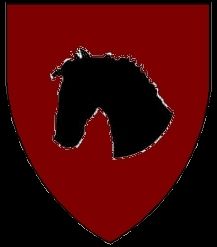
| The Order of Rook Warriors of Rook are followers of Kovas. Their main weapon is a sword. In 1213, Lithuanian Grand Duke and Krivis of Kovas, Dangerutis was captured by Livonian crusaders and imprisoned in Wenden castle. Dangerutis killed himself with his sword. Lithuanians later recovered the sword and dedicated the sword to Kovas. Soon the Order of Rook was established. The sword is carried into every single battle by a Krivis of Kovas for Kovas to revenge for Dangerutis death. Warriors of the order fight on foot or horses. The knights of the order are also known as the Knights of the Black Stallion. | 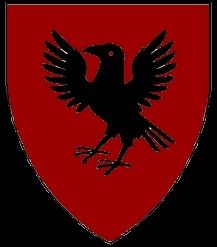
|
The war between Emperor Ordulf the Ill-Ruler and the alliance of Gedvilas of Hungary and Girdenis IV of Lithuania lasted for another 6 years. Neither side was able to gain an upper hand in the war. Lithuanians kept the Imperial Baltic coast and Teutons remained in Esztergom. Several battles followed but none of them had any significance. Due to the stalemate the parties met at Arva Vara, Duchy of Nyitra on 17 March 1411 and signed a peace treaty. In order to secure long lasting peace Girdenis IV agreed to marry his oldest daughter Anele to Ordulf’s third son Dietpold.

Duchess Engeltraud von Sponheim the Great of Carinthia, grandmother of Reinhard Gediminaitis, raised German dukes against Emperor Ordulf in an attempt to regain freedoms once enjoyed by their ancestors. Soon after that the Italian League led by Duke Dietrich IV von Querfurt of Modena began independence war.
Peace did not last long in Lithuania too. Russian princes and boyars rebelled with some support of Lithuanian traitors.
In April 1414, Pope Theodore III declared a Crusade for Hungary. Seven months later the Pope died but new elected Pope Formosus II continued the Crusade. Girdenis IV who was preoccupied with Russian rebels sent two armies to Hungary but by the time they arrived Hungary was devastated by Crusaders. Gedvilas of Hungary fled to Slavonia. On 28 March 1415, he surrendered to Serene Doge of Venice Cangrande di Ravenna. Venetians who financed the Crusade were given the majority of Hungary. Many Hungarian nobles who lost their land fled to Lithuania.

Serene Doge of Venice Cangrande di Ravenna *
On 21 January 1416, Gedvilas was murdered together with his second two year old daughter Etel while staying in Krete, probably under the orders of Greek separatists or maybe disappointed Hungarian nobles who saw him as a traitor and Lithuanian puppet.
Gedvila’s daughter Gyorgyi who luckily stayed with her mother Kenna in County Szekelfold during the murder was crowned as the Queen of Hungary or better say what was left of it.
Girdenis IV returned to Lithuania and crushed the rebels. The loss of a major ally was very painful and Girdenis IV decided to begin a re-conquest of Hungary. In May 1418, war was declared against Venice.

Girdenis IV the Great **
Three months later, Lithuanian armies invaded the Duchy of Ungvar. It took time for Venetians to gather an army of mercenaries and crusaders. On 6 March 1420, 45,000 strong Lithuanian army met 42,000 strong Venetian army at Vac, County Pest. Lithuanian veterans of the war against the Empire broke the left flank led by Hochmeister of Teutonic Order Berengar Niklotid the Drunkard and then surrounded and crushed the remaining Venetian forces. Cangrande and some other leaders, including Grandmaster of Knights Hospitaller Comita de Savoie Ironside managed to avoid capture. Venetians could no longer resist and Cangrade sought truce on 15 May 1420. Kristof Csak the Cruel was returned his Duchy of Ungvar.

The Battle of Vac ***
After the victory against Venice, Hungarian nobles turned their heads towards Lithuania. On 26 September 1421, Queen Gyorgyi fell out a window of castle in Zagreb while playing and died. Nobody was accused of killing but everybody suspected pro-Lithuanian supporters. Girdenis IV wife Anele, older sister of Gedvilas of Hungary became the Queen of Hungary.

Soon after the war against Venice in 1422, Girdenis IV invaded the Republic of Beloozero and seized Novgorod. In 1423, he married his oldest and only son Girdenis to Princess Eleanor Plantagenet of England, the daughter of King Gregory the Wise. King Gregory in 1410 defeated King Ralph, son of King Alan the Just (who overthrew previously the Cathar king) and usurped his throne. Gregory’s ancestors including farther, grandfather and grand-grandfather, King Peter the Strong the first Cathar king were Cathars but he converted to Catholicism in order to get a support against King Ralf.
In 1424, Girdenis IV married his daughter Danilla to Prince Bard Crovan of Scotland. Two years later Bard became the King of Scotland but just 8 months into his rule Bard was murdered. His newly born son Kenneth Crovan became a king. In 1435, Scottish nobles under leadership of Christina Crovan, sister of Kenneth’s Grandfather Fergus of Scotland rebelled. On 7 April 1435, Kenneth with his mother Danilla fled to Lithuania.
By 1430, Emperor Ordulf subdued the Italian League. On 29 September 1433, Duchess Engeltraud of Carinthia died. However, her grandson Reinhardas Gediminaitis took over the leadership of the rebellion his grandmother started. On 14 January 1434, Emperor Ordulf died of consumption. He was the oldest monarch in Europe and outlived his five wives. At the end of his life Ordulf married to sixth wife Ursula von Hohenstaufen, descendant of Sicilian Kings deposed by Ordulf himself.

Ordulf had 6 children – 4 sons and 2 daughters.

He had his first son Duke Ordulf II of Greater Poland with his lover Ursula. Ursula was previously Ordulf’s father’s, Dietpold II lover. She had with him son Duke Adam of Nyitra, Ordulf’s half-brother.
With his first wife, Barbara Askanien, Ordulf had daughter Princes Barbara and two sons Duke Rudolf of Susa and Prince Dietpold. Empress Barbara was considered genius but it was suspected that she preferred women which led to Ordulf’s infidelity. Prince Dietpold married to Anele of Lithuania, daughter of Girdenis the Great but died childless.
The second wife, Walpurga Wettin was a widow of Duke Peter II of Holland. She had no children with Ordulf.
The third wife, Kriemhild von Oberbayern, was imbecile but she gave birth to Princes Agnes.
The forth wife, Giuseppa was a widow of Baron Bruno of Gatteo. She had no children with Ordulf.
The fifth wife, Ermengard von Hohenstaufen was daughter of Ordulf’s half-brother, Duke Adam of Nyitra. She gave birth to Prince Gotzelo.
The last wife, Ursula von Hohenstaufen was also daughter of Duke Adam of Nyitra. Ursula had no children with Ordulf. Like Empress Barbara, Ursula was a man in nature. She preferred sword fighting to embroidery and poetry. She was wroth and suffered numerous scars from fighting.
Following Emperor Ordulf’s death, his grand-grandson Ordulf II, grandson of Duke Ordulf II of Greater Poland was elected Emperor of the Holy Roman Empire.
* It is a picture of Serene Doge Tommaso Mocenigo 1343–1423 (Serene Doge 1414–1423)
** It is a picture of Grand Duke Vytautas the Great 1350–1430 (Grand Duke 1392–1430)
*** It is a picture of the Battle of Pabaiskas on 1 September 1435
Last edited:
Six wives? How many children did he have?
Good to see you were able to get a white peace. Surely this is a sign of Lithuania's growing standing in the world?
Good to see you were able to get a white peace. Surely this is a sign of Lithuania's growing standing in the world?
Six wives? How many children did he have?
He had 6 children - 4 sons and 2 daughters, or on average 1 per wife. I added some extra information about Ordulf's family life (see above), as I thought it is worth to mention
Good to see you were able to get a white peace. Surely this is a sign of Lithuania's growing standing in the world?
HRE has about 280,000 troops. Lithuania has about 100,000. Hungary had about 60,000. Now when Hungary was practically destroyed Lithuania's position became jeopardised again.
Ancient Gods
This is an unusual update – a kind of expansion to the main AAR.
I have added some information about Lithuanian ancient gods at the beginning of each chapter and incorporated some further information into the main text.
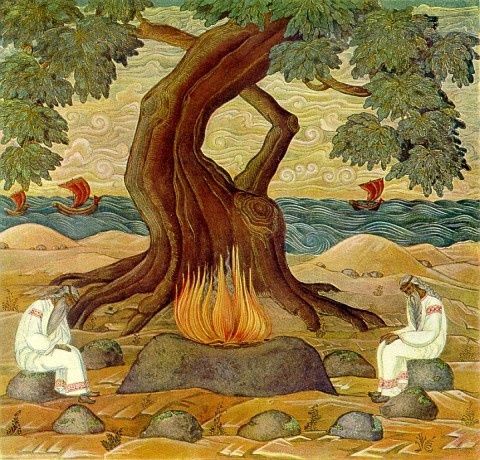
Cosmology – Deivas and Velnias (God and Devil)
Medeina – Goddess of Forest
Teliavelis – Giant Smith
Gabija – Goddess of Fire
Milda – Goddess of Love
Žemyna – Goddess Earth
Perkūnas – God of Sky (Thunder)
The Order of the Black Axe
Saulė – Goddess Sun
Mėnuo – God Moon
Kovas – God of War
The Order of Rook
Vėjopatis – God of Sea
This is an unusual update – a kind of expansion to the main AAR.
I have added some information about Lithuanian ancient gods at the beginning of each chapter and incorporated some further information into the main text.

Cosmology – Deivas and Velnias (God and Devil)
Medeina – Goddess of Forest
Teliavelis – Giant Smith
Gabija – Goddess of Fire
Milda – Goddess of Love
Žemyna – Goddess Earth
Perkūnas – God of Sky (Thunder)
The Order of the Black Axe
Saulė – Goddess Sun
Mėnuo – God Moon
Kovas – God of War
The Order of Rook
Vėjopatis – God of Sea
Last edited:
That was really interesting. I can't claim to have known anything about the Ancient Gods, so that certainly makes the whole thing seem a bit more 'real.'
I like the clean style of the early posts and the extra info about the culture. The origin story seems almost too Christian, but I guess it wasn't written down til well after the missionaries had been through. Anyway, good work.I have added some information about Lithuanian ancient gods at the beginning of each chapter and incorporated some further information into the main text.
That was really interesting. I can't claim to have known anything about the Ancient Gods, so that certainly makes the whole thing seem a bit more 'real.'
I thought that the Ancient Gods theme was missing the Ancient Gods. So I done some research and learned myself
The origin story seems almost too Christian, but I guess it wasn't written down til well after the missionaries had been through. Anyway, good work.
Thank you and welcome to the thread.
The origin story seems almost too Christian, but I guess it wasn't written down til well after the missionaries had been through. Anyway, good work.
It is probably I am influenced by Christian culture
For example in some versions Devil was an older brother and then God appeared or was created, some versions God created devil with a spark. In the version I chose the version where they were brothers together at the beginning. Actually Zeus and Hades were brothers too in Greek mythology, and Zeus was younger brother. The underworld was not really the Hell in Christian sense. It was more like Hades' world. Lithuanian Devil is not Christian either. He is protector of flocks and renown for wisdom and was receiving sacrifices in return for help. Christians just took pagan god Velnias name and made him Devil in Christian sense. Like Dievas became God.
Nonetheless, there are some significant differences. In Lithuanian mythology both God and Devil created the world and humans were created by an accident and not on purpose even though they have divine origin. In some versions God spit and later humans appeared from God's saliva . He was surprised then to see them because he did not create them.
Last edited:
King Girdenis IV the Great (Part III)
After the death of Emperor Ordulf in 1434, the Italian League led by Duke Dietrich IV von Querfurt of Modena began another independence war. Soon after, German nobles became restless in Silesia. Duke Georg I, the Great of Nyitra refused to pay taxes to the Emperor.
Lithuanian army invaded Silesia and captured Upper Silesia and Opole by the end of 1434. In the next year Girdenis IV invaded Venetian and Bulgarian held Wallachia. By the end of the year, almost whole Wallachia was under Lithuanian rule.
On 1 October 1438, Reinhardas Gediminaitis ended 37 years lasting rebellion which was started by his grand-mother Duchess Engeltraud von Sponheim the Great of Carinthia. He swore fealty to Emperor Ordulf II. Reinhardas then successfully mediated marriage between Girdenis IV daughter Audra and Emperor Ordulf II.
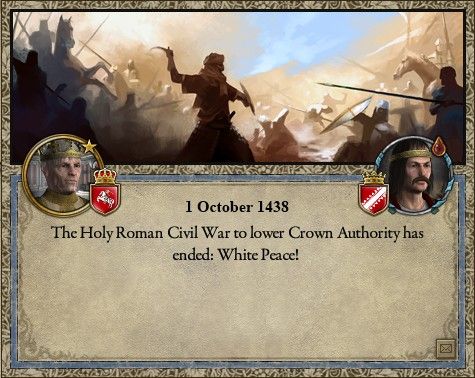
In 1438, Lithuania invaded southern Hungary which was under Venetian control. Venetians and their mercenaries could not resist Lithuanian pressure. On 11 December 1439, Doge Cangrande died. Venetians sought peace. In 1440, the Duchy of Temes and county Feher was transferred to Lithuania.
Following several border skirmishes, Girdenis IV declared war against Duke Georg I, the Great of Nyitra. Without the support of the Empire Georg soon surrendered and yielded County of Zvolen to Girdenis IV. That was the last Girdenis IV conquest.
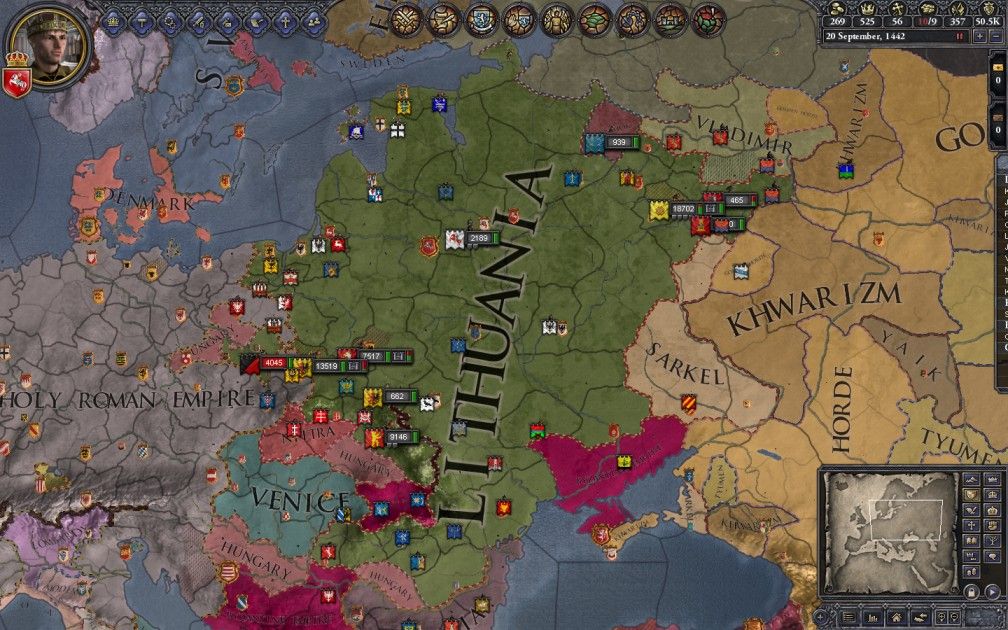
Few months later in July 1441, the Italian League defeated Imperial Army in northern Italy. Duchies of Modena and Tuscany, the Republic of Lombardy and counties of Spoleto and Firenze gained independence.
On 20 September 1442, Girdenis IV, the Great died. He was the longest ruling King of Lithuania.
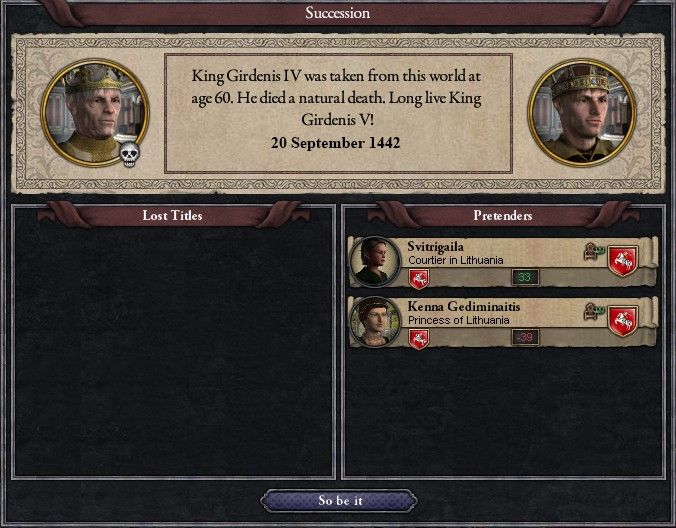
He had seven daughters and one son. Anele married Dietpold, son of Emperor Ordulf the Ill-Ruler, but Dietpold died soon after the marriage. Kenna married Duke Alemerich II of Moravia. Gaudimante married Prince Pedro of Portugal. Birute married Duke Lothar III of Capua. Jevna married King Osorio of Castille.
Dannila married King Bard of Scotland but he died soon after the marriage and his son Kenneth was deposed by aunty Christina who took the throne. Dannila and her son escaped to Lithuania. Girdenis V married Eleanor Plantagenet, sister of King Thomas of England.

By the end of Girdenis IV rule the Europe became relatively stable. Just few wars were still on going. Finland waged an independence war against Sweden. The Duke Matthew of Norfolk disputed the throne of King Thomas of England. And Duke Carless II de Barcelona fought for the crown of Aragon which is currently held by King Poncd’Empuries, the Drunkar. Almohad Sultanate declared a holy war against Portugal.
The situation in Asia was less stable. The Golden Horde and the Sultanate of Egypt imploded. The King of Anatolia invaded Byzantine Empire.

After the death of Emperor Ordulf in 1434, the Italian League led by Duke Dietrich IV von Querfurt of Modena began another independence war. Soon after, German nobles became restless in Silesia. Duke Georg I, the Great of Nyitra refused to pay taxes to the Emperor.
Lithuanian army invaded Silesia and captured Upper Silesia and Opole by the end of 1434. In the next year Girdenis IV invaded Venetian and Bulgarian held Wallachia. By the end of the year, almost whole Wallachia was under Lithuanian rule.
On 1 October 1438, Reinhardas Gediminaitis ended 37 years lasting rebellion which was started by his grand-mother Duchess Engeltraud von Sponheim the Great of Carinthia. He swore fealty to Emperor Ordulf II. Reinhardas then successfully mediated marriage between Girdenis IV daughter Audra and Emperor Ordulf II.

In 1438, Lithuania invaded southern Hungary which was under Venetian control. Venetians and their mercenaries could not resist Lithuanian pressure. On 11 December 1439, Doge Cangrande died. Venetians sought peace. In 1440, the Duchy of Temes and county Feher was transferred to Lithuania.
Following several border skirmishes, Girdenis IV declared war against Duke Georg I, the Great of Nyitra. Without the support of the Empire Georg soon surrendered and yielded County of Zvolen to Girdenis IV. That was the last Girdenis IV conquest.

Few months later in July 1441, the Italian League defeated Imperial Army in northern Italy. Duchies of Modena and Tuscany, the Republic of Lombardy and counties of Spoleto and Firenze gained independence.
On 20 September 1442, Girdenis IV, the Great died. He was the longest ruling King of Lithuania.

He had seven daughters and one son. Anele married Dietpold, son of Emperor Ordulf the Ill-Ruler, but Dietpold died soon after the marriage. Kenna married Duke Alemerich II of Moravia. Gaudimante married Prince Pedro of Portugal. Birute married Duke Lothar III of Capua. Jevna married King Osorio of Castille.
Dannila married King Bard of Scotland but he died soon after the marriage and his son Kenneth was deposed by aunty Christina who took the throne. Dannila and her son escaped to Lithuania. Girdenis V married Eleanor Plantagenet, sister of King Thomas of England.

By the end of Girdenis IV rule the Europe became relatively stable. Just few wars were still on going. Finland waged an independence war against Sweden. The Duke Matthew of Norfolk disputed the throne of King Thomas of England. And Duke Carless II de Barcelona fought for the crown of Aragon which is currently held by King Poncd’Empuries, the Drunkar. Almohad Sultanate declared a holy war against Portugal.
The situation in Asia was less stable. The Golden Horde and the Sultanate of Egypt imploded. The King of Anatolia invaded Byzantine Empire.

Last edited:
YAY! Back! I hope to see you continue your HOI3 AAR's to at some point, your Luxemburg one was the first AAR I read! Anyway good update, and I am really happy to see you coming back again!
Great to see this one come back to life.Keep up the good work!
Thank you, gela1212! Yes, back to life/light
YAY! Back! I hope to see you continue your HOI3 AAR's to at some point, your Luxemburg one was the first AAR I read! Anyway good update, and I am really happy to see you coming back again!
Thank you, Belgiumruler! I will have some more free time until the end of summer. I will try to update other AARs too.
King Girdenis V the Holy (Part I)
Girdenis V like many of his ancestors was a skilled diplomat. At the age of 37, when his father died, he was already well known and respected by Bajorai. He was the only son of Gridenis the Great which also meant that he had no serious pretenders to the throne of Lithuania.
Knowing that his brother in-law Emperor Ordulf II was not a serious threat, Girdenis decided to invade Transylvania, which was held by Hungarian nobles loyal to Empress Thelka, the Great of Byzantium hoping for a quick victory, because Empress Thelka was at war with the Kingdom of Anatolia.
Transylvania was overrun in no time but Empress Thelka refused to recognise the loss of the duchy. Luckily for Byzantines a civil war broke out in the Kingdom of Anatolia and Anatolians sought peace. Lithuanians invaded Taurica. After a few years of hostilities Empress Thelka unexpectedly found another ally. It was Pope Conon II. He declared the Crusade for Hungary on 5 April 1445.
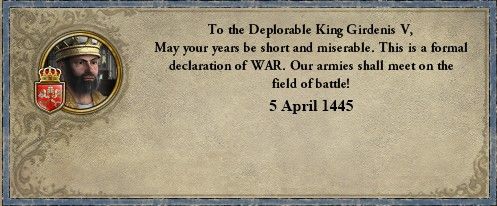
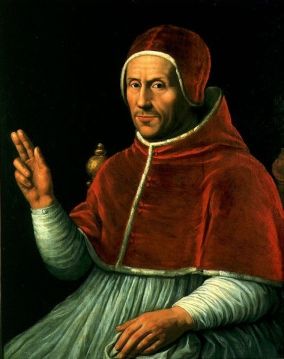
Pope Conon II *
A Crusaders army sponsored by the Pope and Venetians invaded the Duchy of Temes. Emperor Ordulf II refused to join the Crusade, which probably saved Lithuania for a defeat.
In April 1445, 23,000 Byzantines landed in Lower Don led by Despot Kosmin of Serbia. Small Lithuanian armies, which at that time were besieging towns and castles in Traurica, lifted sieges and retreated behind the Dniepr River.
An army of 40,000 soldiers was assembled. On 1 June 1445, Lithuanian army led by Butigeidis is Hapsalo of Strewa crossed the Dniepr River and attacked Byzantines at Huliaipole. Lithuanians were met by horse archers, who then retreated. Lithuanian light cavalry pursued the horse archers but was then ambushed and had to retreat. Lithuanian light and heavy infantry joined the battle. After the initial success, Lithuanians sent reserves into the battle in order to finish off Byzantines, but then horse archers re-entered the battle followed by a wall of 5,500 Byzantine heavy cavalry.
The heavy cavalry smashed through Lithuanian left flank and went behind the centre crushing and routing Lithuanian archers. The centre, mainly composed of heavy infantry began to shatter. A retreat was sounded. Only about 15,000 Lithuanian managed to escape and cross the Dniepr River. While Butigeidis was not a brilliant field leader, he, however, was very good organiser and managed to save the remaining army by a quick and organised retreat.
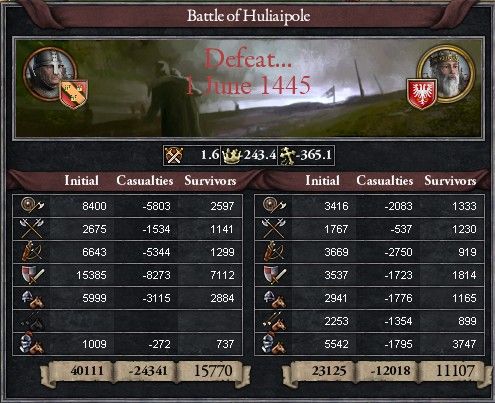
For the next 9 months Butigeidis tried to avoid any major battles with Kosmin while the back-bone of Lithuanian army, warriors of the Order of the Black Axe and the Order of Rook, were fighting off Crusaders in Hungary.
In February 1446, Byzantines invaded the Duchy of Kiev, took Korsun and besieged Kaniv. In late February Lithuanian reinforcements arrived from Hungary led by young Gediminas is Zubstovo. He began his military career as a captain of the Black Horse Knights company and earned his reputation as a ruthless leader in battles in southern Hungary. Gediminas was made Regimentorius (Army General) of the eastern army.
On 1 March 1446, 48,000 Lithuanians arrived at Kaniv. Reinforced 27,000 strong Byzantine army was already waiting for Lithuanians. This time, Gediminas was aware of the strength of Byzantine cavalry and elite heavy infantry supported by companies of the Black Axe Order moved into a battle in a orderly manner.
Byzantine, horse archers were unable to cause any significant damage to armoured infantry. Kosmin ordered a heavy cavalry charge but it badly failed against disciplined hard-core veterans. The knights of the Black Horse and Rook entered the battle and routed Byzantine light cavalry and then the remaining heavy cavalry. The battle has ended by 3pm. Only 6,000 Byzantines together with Despot Kosmin escaped the battle.
Despot Kosmin was pursued to Taurica. One by one Taurica’s towns and castles fell and on 25 April 1446, Empress Thelka surrendered her rights to Transyvlania.
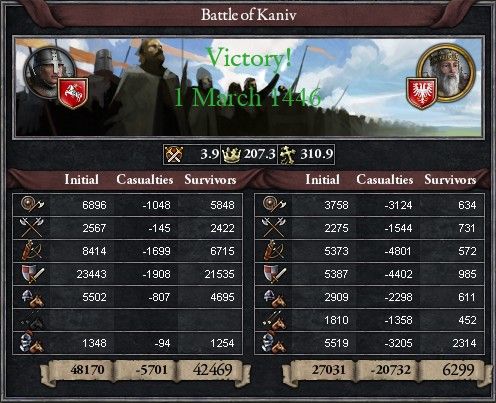
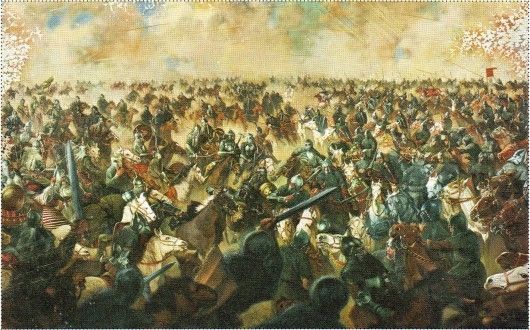
The Battle of Kaniv **
For almost one and a half more years, Lithuanians and Crusaders were fighting in Hungary when Girdenis V decided to attempt a daring move and launch a sea expedition. A large fleet was assembled in Klaipeda, the gates of Vėjopatis. Another fleet was assembled at Cetatea Alba, the Black Sea.
After several months of preparations and sailing, the first fleet arrived to Italy at the beginning of January 1448. A 5,000 strong army led by Vaisvilkas of Trakai landed at Ostia and secured a harbour. The remaining armies arrived a couple of weeks later and immediately marched to Rome. After 6 days of siege on 1 February 1448, 37,000 men under Vaisvilkas of Trakai and Gediminas is Zubstovo stormed Rome’s walls. The city fell but Pope Conon II was rowed down the centre of the Tiber unnoticed. He was later picked up by a Florentine vessel and escaped.
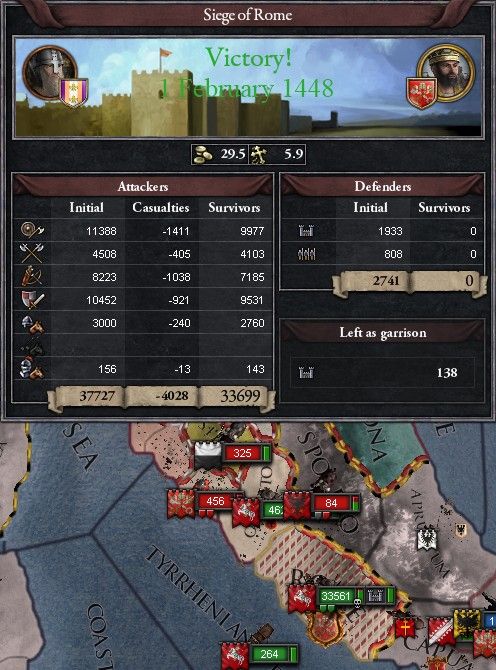
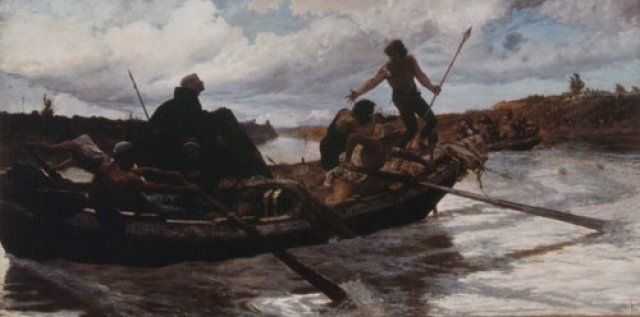
Pope Conon II rowed down the Tiber escaping Rome ***
Rome was sacked by Lithuanian pagans 364 years after the last sack of Rome in 1084 by the Normans under Robert Guiscard or 1838 years after the last pagan army sacked Rome in 390 BC by the Gauls under Brennus.
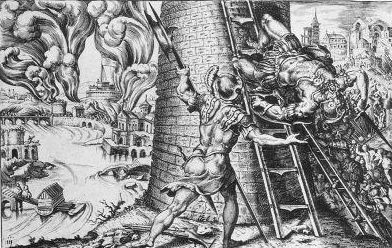
Sack of Rome ****
It was a disaster for the Christendom. However, Pope Conon II, did not called off the Crusade until 11 May 1449. By that time Lithuanians controlled most of Hungary and Papal States and no further Christian volunteers were forthcoming. As a consequence the Republic of Venice surrendered the County of Csanad and Duke Georg of Nyitra surrendered the County of Gemer.
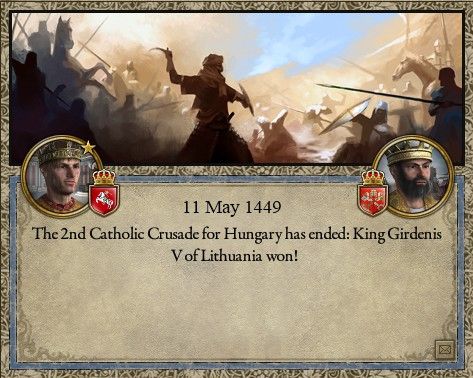
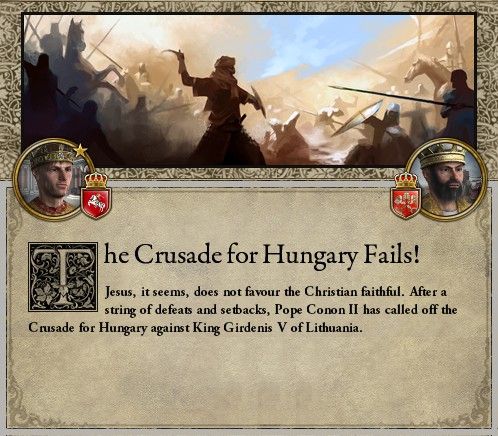
King Poncd’Empuries, the Drunkar of Aragon defeated Duke Carless II de Barcelona and forced renegades Plantagenets, who escaped to Tunisia, into submission. Then united Aragon invaded an old enemy Alhohad Sultanate which was at war with Portugal. Both Aragonesse and Portuguese armies defeated the sultanate. King Alfonso II the Bold of Portugal liberated all Portugal from Muslims and King Ponc conquered Mauretania.
In 1448, King Girdenis’ V brother in-law King Osorio lost his Castille crown to his younger brother Antonio who was supported by anti-Lithuanian faction of conservative Catholics in a revenge for the Sack of Rome. Ostorio was allowed only to keep Astorga and the title of the King of Leon.
Vėjopatis (wind) – the god of sea and winds. He lives on the High Mountain between two rivers. He is scorching, unrelenting, described as an evil spirit, bearded, with wings, and two faces, with a cock on a head, fish in a left hand and pot in the right hand. This god is a vindictive and does not like those who enter his holdings. His biggest temple is in Klaipėda. Once people angered Vėjopatis. He caused storms and huge waves. God Karvaitis’ daughter Neringa stood up to defend people. She scooped up sand to her apron, carried to the sea, and poured into water. Where sand fell there dunes rose until a long spit was formed. | 
|
Girdenis V like many of his ancestors was a skilled diplomat. At the age of 37, when his father died, he was already well known and respected by Bajorai. He was the only son of Gridenis the Great which also meant that he had no serious pretenders to the throne of Lithuania.
Knowing that his brother in-law Emperor Ordulf II was not a serious threat, Girdenis decided to invade Transylvania, which was held by Hungarian nobles loyal to Empress Thelka, the Great of Byzantium hoping for a quick victory, because Empress Thelka was at war with the Kingdom of Anatolia.
Transylvania was overrun in no time but Empress Thelka refused to recognise the loss of the duchy. Luckily for Byzantines a civil war broke out in the Kingdom of Anatolia and Anatolians sought peace. Lithuanians invaded Taurica. After a few years of hostilities Empress Thelka unexpectedly found another ally. It was Pope Conon II. He declared the Crusade for Hungary on 5 April 1445.


Pope Conon II *
A Crusaders army sponsored by the Pope and Venetians invaded the Duchy of Temes. Emperor Ordulf II refused to join the Crusade, which probably saved Lithuania for a defeat.
In April 1445, 23,000 Byzantines landed in Lower Don led by Despot Kosmin of Serbia. Small Lithuanian armies, which at that time were besieging towns and castles in Traurica, lifted sieges and retreated behind the Dniepr River.
An army of 40,000 soldiers was assembled. On 1 June 1445, Lithuanian army led by Butigeidis is Hapsalo of Strewa crossed the Dniepr River and attacked Byzantines at Huliaipole. Lithuanians were met by horse archers, who then retreated. Lithuanian light cavalry pursued the horse archers but was then ambushed and had to retreat. Lithuanian light and heavy infantry joined the battle. After the initial success, Lithuanians sent reserves into the battle in order to finish off Byzantines, but then horse archers re-entered the battle followed by a wall of 5,500 Byzantine heavy cavalry.
The heavy cavalry smashed through Lithuanian left flank and went behind the centre crushing and routing Lithuanian archers. The centre, mainly composed of heavy infantry began to shatter. A retreat was sounded. Only about 15,000 Lithuanian managed to escape and cross the Dniepr River. While Butigeidis was not a brilliant field leader, he, however, was very good organiser and managed to save the remaining army by a quick and organised retreat.

For the next 9 months Butigeidis tried to avoid any major battles with Kosmin while the back-bone of Lithuanian army, warriors of the Order of the Black Axe and the Order of Rook, were fighting off Crusaders in Hungary.
In February 1446, Byzantines invaded the Duchy of Kiev, took Korsun and besieged Kaniv. In late February Lithuanian reinforcements arrived from Hungary led by young Gediminas is Zubstovo. He began his military career as a captain of the Black Horse Knights company and earned his reputation as a ruthless leader in battles in southern Hungary. Gediminas was made Regimentorius (Army General) of the eastern army.
On 1 March 1446, 48,000 Lithuanians arrived at Kaniv. Reinforced 27,000 strong Byzantine army was already waiting for Lithuanians. This time, Gediminas was aware of the strength of Byzantine cavalry and elite heavy infantry supported by companies of the Black Axe Order moved into a battle in a orderly manner.
Byzantine, horse archers were unable to cause any significant damage to armoured infantry. Kosmin ordered a heavy cavalry charge but it badly failed against disciplined hard-core veterans. The knights of the Black Horse and Rook entered the battle and routed Byzantine light cavalry and then the remaining heavy cavalry. The battle has ended by 3pm. Only 6,000 Byzantines together with Despot Kosmin escaped the battle.
Despot Kosmin was pursued to Taurica. One by one Taurica’s towns and castles fell and on 25 April 1446, Empress Thelka surrendered her rights to Transyvlania.


The Battle of Kaniv **
For almost one and a half more years, Lithuanians and Crusaders were fighting in Hungary when Girdenis V decided to attempt a daring move and launch a sea expedition. A large fleet was assembled in Klaipeda, the gates of Vėjopatis. Another fleet was assembled at Cetatea Alba, the Black Sea.
After several months of preparations and sailing, the first fleet arrived to Italy at the beginning of January 1448. A 5,000 strong army led by Vaisvilkas of Trakai landed at Ostia and secured a harbour. The remaining armies arrived a couple of weeks later and immediately marched to Rome. After 6 days of siege on 1 February 1448, 37,000 men under Vaisvilkas of Trakai and Gediminas is Zubstovo stormed Rome’s walls. The city fell but Pope Conon II was rowed down the centre of the Tiber unnoticed. He was later picked up by a Florentine vessel and escaped.


Pope Conon II rowed down the Tiber escaping Rome ***
Rome was sacked by Lithuanian pagans 364 years after the last sack of Rome in 1084 by the Normans under Robert Guiscard or 1838 years after the last pagan army sacked Rome in 390 BC by the Gauls under Brennus.

Sack of Rome ****
It was a disaster for the Christendom. However, Pope Conon II, did not called off the Crusade until 11 May 1449. By that time Lithuanians controlled most of Hungary and Papal States and no further Christian volunteers were forthcoming. As a consequence the Republic of Venice surrendered the County of Csanad and Duke Georg of Nyitra surrendered the County of Gemer.


King Poncd’Empuries, the Drunkar of Aragon defeated Duke Carless II de Barcelona and forced renegades Plantagenets, who escaped to Tunisia, into submission. Then united Aragon invaded an old enemy Alhohad Sultanate which was at war with Portugal. Both Aragonesse and Portuguese armies defeated the sultanate. King Alfonso II the Bold of Portugal liberated all Portugal from Muslims and King Ponc conquered Mauretania.
In 1448, King Girdenis’ V brother in-law King Osorio lost his Castille crown to his younger brother Antonio who was supported by anti-Lithuanian faction of conservative Catholics in a revenge for the Sack of Rome. Ostorio was allowed only to keep Astorga and the title of the King of Leon.
* It is a picture of Pope Eugene IV (Pope 1431-1447).
** It is a picture of the Battle of Blue Waters in autumn 1363 when 20,000-25,000 Lithuanians defeated 10,000-20,000 Mongols.
*** It is a picture of Pope Eugene IV rowed down the Tiber escaping Rome in June 1434.
**** It is a picture of the Sack of Rome in 1527
Last edited:
How have I missed this until today?! Excellent AAR, definitely subscribed.
Really nice AAR. Looking forward to more!
It looks like I missed those posts.
Thank you, Legolas and Sergei Meranov.
It looks like 190 years fly fast in Crusader Kings. Only four years left. Howeve, I still expect some action.

